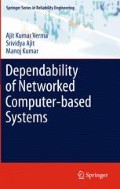Abstract
The word “stochastic” is of Greek origin. In seventeenth century English, the word “stochastic” had the meaning “to conjecture, to aim at mark”. It is not quite clear how it acquired the meaning it has today of “pertaining to chance”.
Access this chapter
Tax calculation will be finalised at checkout
Purchases are for personal use only
Notes
- 1.
The word “stochastic” is of Greek origin. In seventeenth century English, the word “stochastic” had the meaning “to conjecture, to aim at mark”. It is not quite clear how it acquired the meaning it has today of “pertaining to chance”.
References
Cox DR, Miller HD (1970) The theory of stochastic processes. Methuen, London
Trivedi KS (1982) Probability statistics with reliability, queueing, and computer science applications. Wiley, New York
Xinyu Z. (1999) Dependability modeling of computer systems and networks. Ph.D. thesis, Department of Electrical and Computer Engineering, Duke University
IEC 60880-2.0: Nuclear power plants—instrumentation and control systems important to safety—software aspects for computer-based systems performing category a functions, 2006
Erhan C (1975) Introduction to stochastic processes. Prentice-Hall, Englewood Cliffs
Choi H, Kulkarni VG, Trivedi KS (1993) Transient analysis of deterministic and stochastic petri nets. In: Proceedings of the14th international conference on application and theory of petri nets, pp 166–185
Choi H, Kulkarni VG, Trivedi KS (1994) Markov regenerative stochastic petri nets. Perform Eval 20:337–357
Meyer JF (1980) On evaluating the performability of degradable computing systems. IEEE Trans Comp C 29(8):720–731
Meyer JF (1982) Closed-form solutions of performability. IEEE Trans Comp C 31(7):648–657
Puliafito A, Telek M, Trivedi KS (1997) The evolution of stochastic petri nets. In: Proceedings of World Congress of Systems and Simulation, WCSS 97:97
Molloy MK (1982) Performance analysis using stochastic petri nets. IEEE Trans Comp C 31(9):913–917
Murata T (1989) Petri nets: properties, analysis and applications. Proceedings IEEE 77(4):541–580
Peterson PL (1977) Petri nets. ACM Comput Surv 9(3)
Peterson PL (1981) Petri net theory and modeling of systems. PHI, Englewood Cliffs
Jogesh M, Gianfranco C, Trivedi KS (1994) Stochastic reward nets for reliability prediction. Commun Reliab Maintainabil Serviceabil 1(2):9–20
Marsan MA, Balbo G, Conte G (1984) A class of generalized stochastic Petri nets for the performance evaluation of multiprocessor systems. ACM Trans Comp Syst 93:93–122
Ajmone Marsan M, Balbo G, Conte G (1984) A class of generalized stochastic petri nets for the performance evaluation of multiprocessor systems. ACM Trans Comp Syst 2(2):93–122
Marson MA, Balbo G, Bobbio A, Chiola G, Conte G, Cumani A (1989) The effect of execution policies on the semantics and analysis of stochastic petri nets. IEEE Trans Softw Eng 15(7):832–846
Bukowski JV (2001) Modeling and analyzing the effects of periodic inspection on the performance of safety-critical systems. IEEE Trans Reliabil 50(3):321–329
Marsan MA, Chiola G (1987) On petri nets with deterministic and exponentially distributed firing times. In: Advances in Petri Nets 1986, Lecture Notes in Computer Science 266, pp 132–145
Diaz JL, Lopez JM, Gracia DF (2002) Probabilistic analysis of the response time in a real time system. In: Proceedings of the 1st CARTS workshop on advanced real-time technologies, October
Trivedi KS (2001) SPNP user’s manual. version 6.0. Technical report
Zimmermann A (2001) TimeNET 3.0 user manual
Zimmermann A, Michael Knoke (2007) Time NET 4.0 user manual. Technical report, August
Author information
Authors and Affiliations
Corresponding author
Rights and permissions
Copyright information
© 2011 Springer-Verlag London Limited
About this chapter
Cite this chapter
Verma, A.K., Ajit, S., Kumar, M. (2011). Stochastic Processes and Models. In: Dependability of Networked Computer-based Systems. Springer Series in Reliability Engineering. Springer, London. https://doi.org/10.1007/978-0-85729-318-3_3
Download citation
DOI: https://doi.org/10.1007/978-0-85729-318-3_3
Published:
Publisher Name: Springer, London
Print ISBN: 978-0-85729-317-6
Online ISBN: 978-0-85729-318-3
eBook Packages: EngineeringEngineering (R0)

